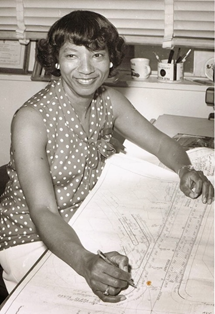InTrans / Nov 12, 2015
Women engineers of the 20th century: Meet Lois Cooper
Go! Magazine
 posted on November 12, 2015
posted on November 12, 2015
This month’s series is dedicated to women engineers that have changed the transportation industry. Women working in an engineering field in the 20th century faced many barriers to success. This typically male-dominated career path has steadily enlarged to include more women, which has further broadened the field of engineering by including women’s ideas, creativity, and values.
Lois Cooper (1931-2014) is known as a “true pioneer” of her time. This woman, who accomplished many “firsts,” was born and raised in Vicksburg, Mississippi. After graduating high school, she began pursuing a law degree at Tougaloo College, located near Jackson.
However, soon after Cooper started attending Tougaloo, she left and moved to California to be with her mother. While there, she found herself back in college at Los Angeles City College studying mathematics.
In 1953, Lois Cooper made history by becoming the first female African American transportation engineer to be hired in the Engineering Department at the California Department of Transportation (Caltrans).

Cooper faced a lot of barriers as an engineer. One of these barriers was discrimination. In an interview about her experiences, Cooper admitted that she faced discrimination early on at Caltrans.
“And it just seems like people are looking at you differently, because you didn’t share bathrooms back in those days.” 1
But what was it really like to be a female engineer in the 1950s? Well, let’s put ourselves in Lois Cooper’s shoes.
What was life like for African American women in the 1950s?
Women during this time had made some progress in the workplace following World War II (WWII) (1939-1945), because they were given greater responsibilities while the men went to war. However, after the war had ended, men undoubtedly returned and took back their responsibilities. Women were demoted and forced, yet again, to choose employment options that were traditionally female-dominated. About 70 percent of women during the late 1950s had assumed clerical roles, while women in management or professional careers only made up about 21 percent. 2
Minority women had even fewer opportunities during this time. The workplace was still segregated due to the Jim Crow laws, which required African Americans be segregated from whites in public facilities in the southern states. Racial segregation was commonplace in America before 1950. Schools were segregated all the way up until the Brown v. Board of Education of Topeka ruling in 1954, where the Supreme Court determined segregated schools for blacks and whites was unconstitutional. However, this integration was met with hostility by many whites. It wasn’t until the Civil Rights Act of 1964 that racial discrimination was outlawed. As such, African American women faced many barriers and typically found employment doing difficult manual labor for very low wages.
Lois Cooper’s achievements
Cooper was not really affected by others thoughts in the workplace and persevered because of her love for mathematics. Starting out as an engineering aide, she worked her way up to eventually become a transportation engineer and project manager. Cooper was figuring out the math behind freeways without calculators by using coordinates, sines, and cosines. Since this was before calculators and computers were able to do this work, Cooper had to figure out the alignment of freeways by determining the bearings and coordinates to create a draft for construction managers. Because of her strong aptitude toward mathematics, her skills gave her an edge over other engineers.
“So even though… they (engineers at Caltrans) may not want a woman, let alone a black woman, but then here I am calculating all this, the alignments with the freeways… so then your reputation gets better.” 3
During her time at Caltrans, she was able to pursue further education and was the second woman in California to pass the professional engineers (PE) license exam. She was involved with the Century Freeway, now called I-105, and was the first female director of the First Diamond Lane, which is the precursor to carpool lanes. She also had a leading role in the Civil Rights Division at Caltrans, which was mandated to hire minority workers in freeway construction since many of the proposed freeways were going through low-income communities in California.
But Cooper was not satisfied. She had been motivated from the beginning to succeed and to be a role model for others.
In the 1970s, Cooper learned about the Los Angeles Council of Black Professional Engineers (LACBPE). She participated by visiting schools to talk to students about considering engineering as a profession. The program showed students the importance of math and science classes. For years after, she would help teach math and science on Saturdays to more than 100 students.
Citations
- [Lois Cooper], interviewed by [Deborah Rice], Profiles of SWE Pioneers Oral History Project, Walter P. Reuther Library and Archives of Labor and Urban Affairs, Wayne State University, [November 5, 2005].
- http://1950s.weebly.com/womens-roles.html
- [Lois Cooper], interviewed by [Deborah Rice], Profiles of SWE Pioneers Oral History Project, Walter P. Reuther Library and Archives of Labor and Urban Affairs, Wayne State University, [November 5, 2005].
By Jackie Nester, Go! Staff Writer